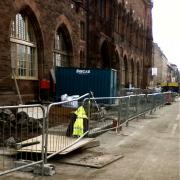
When the National Portrait Gallery reopens its doors on 30 November, it will admit members of the public to an enormously improved and enlarged exhibition space within. The Queen Street pavement outside will also be expanded, stretching to roughly twice its current width on the Gallery's northern elevation.
This prioritisation of pedestrians is very welcome, although it will entail the loss of a minor, peripheral-vision landmark which has long intrigued and comforted passers-by: the small brass letters spelling 'STUART'S GRANOLITHIC'.
[img_assist|nid=1600|title=|desc=|link=node|align=right|width=200|height=171]The Stuart's Granolithic Stone Co. Ltd was established in 1840 by Peter Stuart of Peterhead. The foundation of its success was perfection during the second half of the 19th century of a hard-wearing cement and granite composite, generally laid by screed and then hand trowelled for a smooth finish. By 1890, Building News claimed that this Granolithic had 'revolutionised footpath paving, and become the paving of the world'.
It was particularly noted for its strength and comparative lightness, and was used in the new 'fireproof' Jenner's building (1893–5) and North British Hotel (1902), where 2–3" sections covered areas of 14' x 12' without intermediate joists. Other brassworked instances are to be found on George Street and the Calton Road back entrance to Waverley Station.
[img_assist|nid=1588|title=|desc=|link=node|align=right|width=150|height=200]Elsewhere, Stuart's paved the City of London in 1880 and the Rue de Rivoli in Paris (1883). As reinforced ferro-concrete technology developed, so Stuart's also became involved in construction of the New City Hall in Philadelphia (1901, design by Scot John McArthur), at that time the tallest habitable building in the world.
Back in Edinburgh, the National Portrait Gallery (design by Robert Rowand Anderson) was built between 1885 and 1889 on virgin ground which had previously been a walled garden owned by St Andrew Square proprietors (see 1873–6 OS map overlaid on Google Earth image below). The Granolithic pavement which survived here up until recently may therefore very well have been original. However, developers – aware of unsightly and potentially trip-hazardous cracks – opted for smart new sandstone slabs rather than piecemeal patching. The original brass letters are, a Gallery spokesperson assures us, 'retained on site', although to what purpose remains unclear.
'The advent of ready mixed concrete and advances in mix design, concrete consistency and laying techniques signalled the end of granolithic paving towards the end of the 20th century,' laments the Stuart's website, prompting the firm to change its name to Stuarts Industrial Flooring Limited in June 1988. It is not involved in the latest refurbishment and improvement of the National Portrait Gallery.
For the finest example we've found of Stuart's brasswork – in Holland Road, Hove – visit: http://bit.ly/hTuGaS.